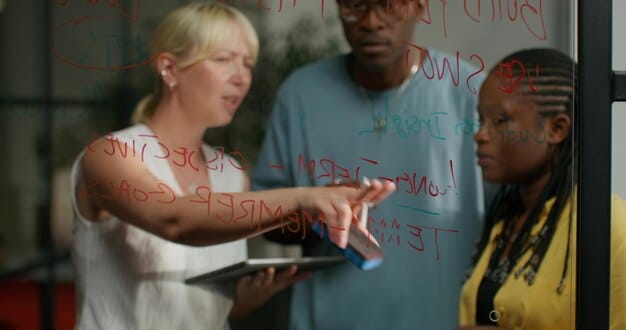Conflict Resolution: Navigating Workplace Conflicts for Stronger Teams

Navigating workplace conflicts effectively is paramount for fostering stronger professional relationships and a productive environment, demanding a strategic approach to communication and resolution techniques.
In any professional setting, the emergence of disagreements is not a matter of if, but when. Far from being inherently detrimental, these moments, when managed adeptly, can become catalysts for growth and innovation. Understanding effective Conflict Resolution: Strategies to Navigate Workplace Conflicts and Build Stronger Relationships isn’t merely about mitigating disputes; it’s about transforming potential discord into opportunities for enhanced collaboration and team cohesion. This journey explores practical frameworks to tackle these challenges head-on.
Understanding the Roots of Workplace Conflict
Understanding the underlying causes of workplace conflict is the crucial first step toward effective resolution. Conflicts rarely emerge in a vacuum; they often stem from a complex interplay of individual differences, structural issues, and communication breakdowns. Recognizing these origins allows for targeted interventions rather than superficial fixes. It requires a keen eye for both the obvious and the subtle tensions brewing beneath the surface of daily interactions.
Common Sources of Disagreement
Many workplace conflicts can be traced back to a handful of recurrent causes. These range from personality clashes to more systemic issues within the organizational structure. Identifying these common threads helps leaders and team members anticipate potential friction points and address them proactively. It’s about more than just identifying the “what”; it’s dissecting the “why.”
- Communication Breakdown: Misunderstandings, lack of clear instructions, or failure to listen actively can quickly escalate minor issues into significant disputes.
- Conflicting Personalities or Work Styles: When individuals with vastly different approaches to tasks or interpersonal interactions are forced to collaborate closely, friction can arise.
- Role Ambiguity or Overlap: Unclear job descriptions or overlapping responsibilities can lead to power struggles, resentment, and a perception of unfair workload distribution.
- Limited Resources: Competition for shared resources, such as budgets, equipment, or even management attention, often breeds conflict among departments or teams.
The Impact of Organizational Culture
The prevailing organizational culture significantly influences how conflicts emerge, are perceived, and are ultimately managed. A culture that encourages open dialogue and constructive feedback might see conflicts as opportunities, whereas a suppressive culture could lead to grievances festering in silence. The impact extends beyond individual interactions, shaping the very fabric of team dynamics. It defines the unwritten rules of engagement, influencing whether conflicts are addressed head-on or swept under the rug. An office environment where trust is low or fear of reprisal is high will naturally have different conflict patterns than one built on psychological safety. Leadership’s role in modeling positive conflict engagement is paramount here, setting the tone for how employees view and approach disagreements.
Identifying Triggers and Early Warning Signs
Before a situation erupts into a full-blown conflict, there are often subtle cues or “red flags” that, if noticed, can provide an opportunity for early intervention. These might include changes in communication patterns, increased absenteeism, or a general decline in team morale. Being attuned to these triggers allows for proactive management rather than reactive damage control. Early detection prevents minor disagreements from spiraling out of control, saving time and emotional energy. Regular check-ins, anonymous feedback mechanisms, and an open-door policy can help surface these signs before they become critical. It’s about cultivating an environment where concerns can be voiced safely, without fear of judgment or negative repercussions.
The ability to diagnose the root causes of conflict is a foundational skill for anyone looking to build a more harmonious and productive workplace. It moves beyond merely reacting to symptoms and delves into addressing the systemic issues that perpetuate tension. By understanding why conflicts happen, we become better equipped to prevent them and to resolve them effectively when they do arise.
Communication: The Cornerstone of Resolution
Effective communication is not merely a tool in conflict resolution; it is the very foundation upon which successful outcomes are built. Without clear, empathetic, and respectful dialogue, even the most well-intentioned efforts to mediate a dispute are likely to falter. This section explores why communication is so critical and how to leverage it to foster understanding and collaboration during workplace disagreements. It’s about moving beyond assumptions and into a space of shared meaning.
Active Listening and Empathy
True understanding in a conflict situation begins with active listening. This means going beyond simply hearing words to truly comprehending the other person’s perspective, feelings, and underlying needs. Coupled with empathy – the ability to put oneself in another’s shoes – active listening can transform a heated argument into a constructive dialogue. It allows individuals to feel heard and validated, which often de-escalates tension and opens the door for finding common ground. Practicing reflective listening, where you paraphrase what you’ve heard, reinforces understanding and demonstrates genuine engagement. Developing these skills is not just about resolving current disputes, but building a culture of respect and mutual understanding that prevents future ones.
The Power of “I” Statements
When expressing feelings or concerns during a conflict, using “I” statements rather than “you” statements can significantly reduce defensiveness and promote a more productive conversation. Instead of saying, “You always miss deadlines,” which sounds accusatory, one might say, “I feel concerned when deadlines are missed because it impacts my ability to complete my tasks on time.” This shifts the focus from blame to personal impact, making the other party more receptive to the message. “I” statements focus on individual feelings and observations, promoting accountability without aggression. This method fosters a collaborative approach to problem-solving, as it invites discussion rather than shutting it down.
Non-Verbal Cues and Body Language
Communication is not solely about spoken words; non-verbal cues and body language transmit a significant portion of our message. During a conflict, an individual’s posture, facial expressions, eye contact (or lack thereof), and gestures can either exacerbate tension or Signal openness and willingness to resolve. Being aware of your own non-verbal signals, as well as interpreting those of others, is crucial for effective communication. Open postures, maintaining appropriate eye contact, and a calm demeanor can convey respect and trustworthiness. Conversely, crossed arms, averted gaze, or fidgeting might suggest defensiveness or disinterest. Mastering this aspect of communication allows for a more nuanced understanding of the conflict dynamic and helps to tailor responses for maximum impact.
Choosing the Right Communication Channel
Not all communication channels are equally effective for conflict resolution. While email might be suitable for minor clarifications, sensitive or emotionally charged conflicts are almost always best handled through face-to-face conversations or video calls. These richer channels allow for immediate feedback, observation of non-verbal cues, and a more personal connection, reducing the likelihood of misinterpretation. Relying too heavily on text-based communication for complex issues can strip away context and lead to further misunderstandings. Selecting the appropriate medium demonstrates thoughtful consideration and an effort to engage meaningfully, improving the chances of a positive resolution.
Ultimately, mastering communication skills is an ongoing process that yields significant dividends in both personal and professional spheres. In the context of workplace conflict, it transforms potentially destructive encounters into constructive dialogues, strengthening relationships and fostering a more resilient team environment. By prioritizing clear, empathetic, and mindful communication, organizations can navigate disagreements with greater ease and emerge stronger.
Strategic Approaches to Conflict Resolution
Beyond effective communication, having a repertoire of strategic approaches is vital for successfully navigating workplace conflicts. These strategies provide frameworks for addressing disputes systemically, moving beyond individual grievances to find sustainable solutions that benefit all parties involved. It’s about employing a thoughtful methodology rather than simply reacting to the immediate tension. Recognizing that not all conflicts are the same, these strategies offer adaptable pathways.
Mediation and Facilitation
When two parties are unable to resolve a conflict on their own, a neutral third party can play an invaluable role through mediation or facilitation. A mediator doesn’t take sides or impose a solution but guides the conversation, helps parties articulate their positions, identifies common ground, and encourages a mutually acceptable resolution. Facilitation, typically less formal than mediation, involves guiding a group discussion to achieve a shared understanding or decision. Both processes provide a structured environment that can de-escalate tension and foster constructive dialogue. The presence of a neutral party often helps to curb emotional outbursts and keeps the discussion focused on solutions. Skilled mediators are adept at reframing issues, asking probing questions, and ensuring all voices are heard equitably, making it a powerful tool for complex disputes.

Negotiation Techniques
Negotiation is at the heart of many conflict resolution processes, involving parties discussing their differences to reach an agreement. Effective negotiation moves beyond a win-lose mentality towards a win-win or “integrative” approach, where solutions aim to satisfy the interests of all involved. This requires understanding one’s own needs and interests, as well as those of the other party, to explore creative solutions. Key negotiation techniques include identifying shared interests, brainstorming multiple options, and focusing on objective criteria rather than subjective demands. Often, what appears to be a zero-sum game can be transformed into a collaborative problem-solving exercise through skillful negotiation. Preparing thoroughly, anticipating concerns, and maintaining an open mind are crucial for successful outcomes.
Conflict Resolution Training Programs
Investing in conflict resolution training programs for employees and managers is a proactive strategy that equips teams with the necessary skills before conflicts escalate. These programs typically cover active listening, assertive communication, negotiation tactics, mediation principles, and strategies for managing emotions. By providing a common language and set of tools, such training empowers individuals to address disagreements constructively, reducing the need for formal intervention. It fosters a culture where conflict is seen as an opportunity for growth rather than a threat. Furthermore, it helps standardize approaches to conflict and ensures that everyone operates from a baseline of effective practices. Training can also reduce workplace stress by giving employees confidence in their ability to handle tough conversations.
Addressing Systemic Issues
Sometimes, conflicts are not merely interpersonal but symptoms of deeper, systemic issues within the organization. These could include unclear policies, unfair reward systems, inefficient processes, or a lack of resources. A truly strategic approach to conflict resolution involves identifying and rectifying these systemic problems, rather than just treating the symptoms. This might require conducting organizational reviews, revising policies, or restructuring departments. Addressing the root cause ensures that similar conflicts do not recur, leading to long-term stability and productivity. It’s a move from reactive problem-solving to proactive prevention, building a more resilient and equitable workplace from the ground up. This holistic view recognizes that individual actions are often shaped by the environment they operate within.
By employing these strategic approaches, organizations can move beyond simply managing conflicts to fostering an environment where disagreements are handled constructively, leading to stronger relationships and a more resilient workforce. These methods underscore the importance of preparation, skill development, and a commitment to understanding the deeper dynamics at play.
Building Stronger Relationships Through Conflict
It may seem counterintuitive, but effectively managing workplace conflicts can actually serve as a powerful catalyst for building stronger, more resilient professional relationships. When handled constructively, conflicts provide unique opportunities for deeper understanding, mutual respect, and improved team cohesion. This section explores how to transform moments of disagreement into building blocks for lasting positive connections. It’s about seeing friction not as a destructive force, but as a potential for refinement and growth.
The Role of Psychological Safety
A bedrock principle in transforming conflict into relationship building is the establishment of psychological safety within a team or organization. This refers to an environment where individuals feel safe to take interpersonal risks, speak up, express concerns, and even make mistakes without fear of punishment or humiliation. When psychological safety is present, employees are more likely to participate in difficult conversations, voice dissenting opinions, and engage in open dialogue, crucial for effective conflict resolution. It encourages transparency and vulnerability, allowing conflicts to be surfaced and addressed rather than being suppressed and festering. Leaders play a significant role in modeling and fostering this safety, setting the tone for how conflict is approached. Without it, individuals will self-censor, leading to unresolved issues and superficial relationships.
Learning from Disagreements
Every conflict presents a unique learning opportunity, both for the individuals involved and for the organization as a whole. By reflecting on what went wrong, understanding different perspectives, and analyzing the factors that contributed to the disagreement, teams can gain valuable insights. This learning can lead to improved processes, clearer communication protocols, and a deeper appreciation for diversity in thought. Viewing conflict as a feedback mechanism allows for continuous improvement and helps prevent similar issues from arising in the future. It moves beyond focusing on blame and instead centers on extracting wisdom from challenging experiences. Debriefing after a conflict, even a minor one, can uncover crucial insights into team dynamics and individual working styles.
Repairing Trust and Forgiveness
Post-conflict, especially after a significant disagreement, the process of repairing trust and fostering forgiveness is paramount for rebuilding relationships. This isn’t about forgetting the conflict, but about acknowledging hurt, taking responsibility where appropriate, offering sincere apologies, and demonstrating a commitment to moving forward. Rebuilding trust takes time and consistent positive actions. Forgiveness, in this context, does not mean condoning harmful behavior, but rather letting go of resentment to enable future collaboration. It allows individuals to release the emotional burden associated with unresolved conflict. Leadership can facilitate this by ensuring accountability while also creating space for reconciliation. Acknowledging the emotional residue of conflict is crucial for completely healing the relationship and preventing lingering tension.
Establishing Clear Expectations for Future Interactions
A crucial step in ensuring that conflict strengthens rather than erodes relationships is to establish clear expectations for future interactions after a resolution has been reached. This might involve setting new communication guidelines, clarifying roles and responsibilities, or agreeing on specific behavioral changes. By defining how similar situations will be handled in the future, it provides a roadmap for interaction and reduces the likelihood of recurrent conflicts stemming from the same issues. It transforms a one-time resolution into a sustainable positive change. This proactive approach reinforces commitment to the relationship and demonstrates a shared desire for a more harmonious working environment. Documenting these agreements, even informally, can serve as a valuable reference point.
Ultimately, conflict, when approached with the right mindset and strategies, is not a threat to relationships but an opportunity for their refinement and reinforcement. By fostering psychological safety, embracing learning, actively working to repair trust, and setting clear future expectations, organizations can emerge from disagreements with stronger, more resilient teams, laying the groundwork for sustained collaboration and success.
Manager’s Role in Conflict Resolution
Managers play a pivotal role in shaping how conflicts are addressed within their teams. They are often the first point of contact when disagreements arise, and their approach significantly influences whether a conflict escalates destructively or is resolved constructively. Their responsibilities extend beyond mere mediation; they encompass setting the tone, providing resources, and fostering a culture conducive to healthy conflict engagement. An effective manager acts as both a guide and a facilitator in these challenging situations.
Proactive Conflict Prevention
A good manager doesn’t just react to conflicts; they actively work to prevent them. This involves establishing clear job roles and responsibilities, setting transparent performance expectations, and facilitating open communication channels from the outset. Regular team building activities, fostering psychological safety, and encouraging diversity of thought can also preempt many potential disagreements by building stronger interpersonal bonds and mutual understanding. Proactive prevention means identifying potential friction points before they ignite and addressing underlying tensions. Regular one-on-one check-ins can also serve as early warning systems, allowing managers to address minor issues before they fester. By creating a supportive and clear work environment, managers lay the groundwork for a team that naturally handles differences constructively.
Equipping Employees with Resolution Skills
Beyond preventing conflict, managers have a responsibility to equip their team members with the skills necessary to navigate disagreements on their own. This might involve recommending or providing access to conflict resolution training, coaching individuals on active listening and “I” statements, or encouraging peer mediation for minor disputes. Empowering employees to resolve their own conflicts fosters independence, builds confidence, and reduces reliance on managerial intervention for every small issue. This decentralized approach to resolution can significantly lighten a manager’s load while simultaneously strengthening team capabilities. It transforms managers from problem-solvers into enablers, fostering a self-sufficient and resilient team. Regularly sharing best practices and offering constructive feedback on conflict debriefs also contributes to skill development.
Mediating and Intervening Effectively
When direct intervention is necessary, managers must be skilled mediators. This involves remaining neutral, listening impartially to all sides, helping parties articulate their positions and interests, and guiding them toward a mutually agreeable solution. Effective mediation also requires understanding legal and policy implications, ensuring that resolutions adhere to company guidelines. Managers must know when to step back and when to intervene more assertively, especially in cases of harassment or severe misconduct. Their role is not to impose a solution but to facilitate a fair process and ensure that all voices are heard respectfully. Documenting the process and agreements can also be crucial for accountability. It’s a delicate balance of providing structure and support while allowing the conflicting parties to arrive at their own solutions.
Leading by Example
Perhaps the most powerful tool a manager possesses in conflict resolution is their own behavior. By demonstrating effective communication, showing empathy, maintaining composure under pressure, and openly discussing disagreements in a constructive manner, managers set a powerful example for their teams. Their actions speak louder than any policy or training manual. A manager who avoids difficult conversations or reacts defensively to feedback will inadvertently promote similar behaviors in their team. Conversely, one who models respect, openness, and a solutions-oriented approach creates a culture where constructive conflict becomes the norm. This involves being transparent about their own challenges and how they navigate them. Authentic leadership in this area builds trust and encourages similar candor among team members, fostering an environment where conflict is seen as a normal and manageable part of professional life.
In essence, a manager’s role in conflict resolution is multifaceted: they are preventers, educators, mediators, and most importantly, role models. By embracing these responsibilities, they can transform conflict from a disruptive force into an opportunity for team growth, stronger relationships, and a more vibrant workplace culture.
Long-term Benefits of Healthy Conflict Resolution
The benefits of implementing effective conflict resolution strategies extend far beyond merely settling immediate disputes. When managed healthily, conflicts can serve as powerful catalysts for long-term organizational growth, innovation, and enhanced employee well-being. This section delves into the enduring positive impacts that a robust approach to conflict resolution can yield, transforming potential stumbling blocks into stepping stones for sustained success. It’s about cultivating a resilient culture rather than just extinguishing fires.
Enhanced Employee Engagement and Morale
Workplaces where conflicts are addressed constructively tend to have higher levels of employee engagement and morale. When employees feel their concerns are heard, respected, and dealt with fairly, they are more likely to trust their leaders and colleagues. This sense of psychological safety and fairness reduces stress, fosters loyalty, and encourages individuals to invest more fully in their work and the success of the team. Conversely, unresolved conflicts or a culture of avoidance can lead to cynicism, disengagement, and a high turnover rate. A transparent and equitable conflict resolution process signals that the organization values its people, thereby boosting overall satisfaction and reducing absenteeism. Employees become more invested when they feel their voices matter and their well-being is prioritized.
Fostering Innovation and Creativity
Healthy conflict resolution is paradoxically a driver of innovation and creativity. When diverse viewpoints are encouraged and skillfully navigated, it leads to richer discussions, challenges existing assumptions, and opens doors to new ideas that might otherwise be overlooked. Teams that are comfortable with constructive disagreement are better equipped to brainstorm solutions, critically evaluate concepts, and adapt to change. Conversely, suppressing conflict can lead to “groupthink,” where individuals withhold dissenting opinions to maintain harmony, stifling true innovation. An environment where conflicts are processed openly allows for rigorous debate, leading to more robust solutions and a competitive edge. It signals that questioning the status quo is valued, not feared. This intellectual friction, when managed, sparks true breakthroughs.
Improved Decision-Making
Conflict, when channeled productively, can significantly improve decision-making processes. By encouraging open debate and the exploration of different perspectives, it ensures that decisions are thoroughly vetted, potential pitfalls are identified, and a wider range of options are considered. This prevents hasty or ill-informed choices driven by consensus rather than critical analysis. A healthy conflict resolution approach ensures that all relevant data and viewpoints are brought to the table, leading to more comprehensive and effective outcomes. It moves beyond superficial agreement to a robust examination of choices. Decisions made after constructive conflict are often more resilient, as they have already withstood internal scrutiny.

Reduced Turnover and Absenteeism
High levels of unresolved workplace conflict are directly linked to increased employee turnover and absenteeism. Individuals are far more likely to leave an organization or take sick days when they feel constantly stressed by unresolved tensions or a toxic work environment. By actively addressing conflicts, organizations can create a more positive and supportive atmosphere, leading to better employee retention. This not only saves on recruitment and training costs but also preserves institutional knowledge and continuity. A workplace known for its fair and effective conflict resolution processes becomes an attractive environment, thereby reducing the financial and human costs associated with employee disengagement and departure. Employees are more likely to stay where they feel valued and respected, even amidst disagreements.
Strengthened Organizational Resilience
An organization that effectively manages conflict develops a greater capacity for resilience. It learns to adapt to changing circumstances, overcome internal challenges, and emerge stronger from periods of tension. This resilience is built on the foundation of trust, effective communication, and a shared understanding that challenges can be overcome collectively. Such an organization is not afraid of change; instead, it embraces it, knowing that its mechanisms for addressing friction are robust. This contributes to long-term stability and sustained growth, allowing the organization to weather future storms with greater ease. It’s about building an immune system for the workplace, capable of handling various internal stressors.
In conclusion, healthy conflict resolution isn’t merely about problem-solving; it’s about strategic organizational development. By embracing conflict as a powerful force for good, companies can unlock enhanced engagement, foster true innovation, make superior decisions, retain valuable talent, and build an enduring, resilient culture capable of thriving in an ever-evolving landscape.
Cultivating a Culture of Open Dialogue and Growth
Establishing a workplace where open dialogue and continuous growth are the norms is the ultimate aim of robust conflict resolution practices. It’s about moving beyond reactive problem-solving to proactively shaping an environment where differences are valued, discussions are constructive, and learning is constant. This requires a conscious and sustained effort from leadership and every team member to embed these principles into the daily fabric of the organization.
Encouraging Early Intervention
A culture of open dialogue thrives when individuals feel empowered to address minor disagreements before they escalate into major conflicts. This means encouraging team members to respectfully “call out” issues as they arise, fostering a sense of shared responsibility for maintaining a healthy work environment. Early intervention often simplifies resolution, as perspectives haven’t become deeply entrenched and emotions are less inflamed. Managers can facilitate this by emphasizing psychological safety, signaling that it’s safe to speak up without fear of reprisal. Training in assertive communication and active listening equips employees with the tools to engage in these early conversations effectively. The goal is to normalize addressing discomfort directly and constructively, making it a routine part of collaboration.
Regular Feedback Mechanisms
Creating formal and informal feedback mechanisms is crucial for fostering open dialogue and identifying potential points of friction. This might include regular one-on-one meetings, anonymous suggestion boxes, 360-degree feedback systems, or periodic team pulse surveys. These channels provide opportunities for employees to voice concerns, share ideas, and highlight areas for improvement without waiting for a conflict to erupt. They serve as continuous environmental scans, enabling leadership to take corrective actions before issues fester. A culture that values feedback—both positive and constructive—demonstrates a commitment to continuous improvement and strengthens trust between employees and management. Feedback should be seen as a gift, offering insights for personal and organizational development.
Championing Diversity and Inclusion
A truly open and growth-oriented culture embraces diversity in all its forms, including diversity of thought and perspective. When individuals from varied backgrounds feel genuinely included and respected, they are more likely to bring their authentic selves to work, sharing unique insights that can challenge conventional thinking and lead to richer solutions. Managing conflicts in a diverse team requires an understanding of different communication styles and cultural norms. Actively championing diversity and inclusion means not only inviting diverse voices but also ensuring they are truly heard and valued, transforming potential disagreements into opportunities for collective learning and innovation. This creates a fertile ground where differences are seen as assets, rather than liabilities for conflict.
Continuous Learning and Adaptation
The journey toward a healthy conflict-resolution culture is not a one-time initiative but an ongoing process of continuous learning and adaptation. Organizations must be willing to reflect on past conflicts, analyze what worked and what didn’t, and adjust their strategies accordingly. This involves a commitment to ongoing training, regular evaluation of conflict resolution processes, and an openness to evolving best practices. A growth mindset applied to conflict means seeing every disagreement as a chance to learn, refine, and improve the organizational ecosystem. It’s about fostering an agile and responsive environment that can effectively navigate future challenges by consistently learning from its experiences. This iterative process builds an organization that is not only good at resolving conflicts but also resilient in an ever-changing landscape.
Cultivating a culture of open dialogue and growth positions conflict not as a problem to be avoided, but as an inherent part of human interaction that, when managed well, drives progress and strengthens the very bonds of the workplace. It transforms an organization into a dynamic entity capable of thriving on diversity of thought and continuous self-improvement.
| Key Aspect | Brief Description |
|---|---|
| 🗣️ Communication Mastery | Active listening, empathy, and “I” statements are crucial for resolving disputes constructively. |
| 🤝 Strategic Approaches | Utilize mediation, negotiation, and formal training to address conflicts systematically. |
| 🌱 Relationship Building | Healthy conflict can strengthen bonds and foster psychological safety, leading to deeper trust. |
| 📈 Long-Term Benefits | Leads to improved decision-making, innovation, higher morale, and reduced turnover. |
Frequently Asked Questions about Workplace Conflict Resolution
The most effective first step is typically to engage in direct, private conversation with the other party. Approach the discussion with a calm demeanor, focusing on “I” statements to express your feelings and concerns without blame. Active listening is key to understanding their perspective before seeking a solution.
To foster independent conflict resolution, provide training in communication skills, negotiation, and active listening. Create a psychologically safe environment where employees feel comfortable addressing issues directly and respectfully. Offer guidance and resources, but empower them to find solutions collaboratively rather than immediately stepping in.
A manager should intervene when basic attempts at resolution between parties have failed, if the conflict is escalating and impacting team morale or productivity, or if it involves harassment, discrimination, or a breach of company policy. Their role is to mediate fairly and guide a constructive outcome.
Yes, absolutely. When managed constructively, conflict can lead to deeper understanding, foster innovation by challenging assumptions, improve decision-making through diverse perspectives, and ultimately strengthen team relationships. It pushes individuals and teams to grow, adapt, and become more resilient.
“I” statements express feelings and observations from your perspective, focusing on your experience (“I feel X when Y because Z”). They are crucial because they communicate concerns without sounding accusatory or blaming, which reduces defensiveness and encourages the other party to listen and engage more openly in resolution.
Conclusion
The landscape of any professional environment is inherently dynamic, and with that dynamism comes the inevitability of conflict. However, as this exploration has revealed, the presence of disagreement need not be a source of disruption, but rather a profound opportunity for development. By understanding the multifaceted roots of conflict, mastering the nuances of effective communication, implementing strategic resolution approaches, and recognizing the transformative power of a managerial role, organizations can reshape their relationship with discord. The cultivation of a psychologically safe environment, where open dialogue is not only permitted but encouraged, lays the groundwork for conflicts to be seen as catalysts for innovation, deeper trust, and stronger, more resilient relationships. Ultimately, a proactive and skilled approach to conflict resolution is not merely about problem-solving; it is about strategically investing in human capital, fostering a culture of continuous growth, and building a workplace that fundamentally thrives on its ability to navigate challenges collaboratively. Such an environment ensures not just survival, but sustained flourishing in an ever-evolving world.





